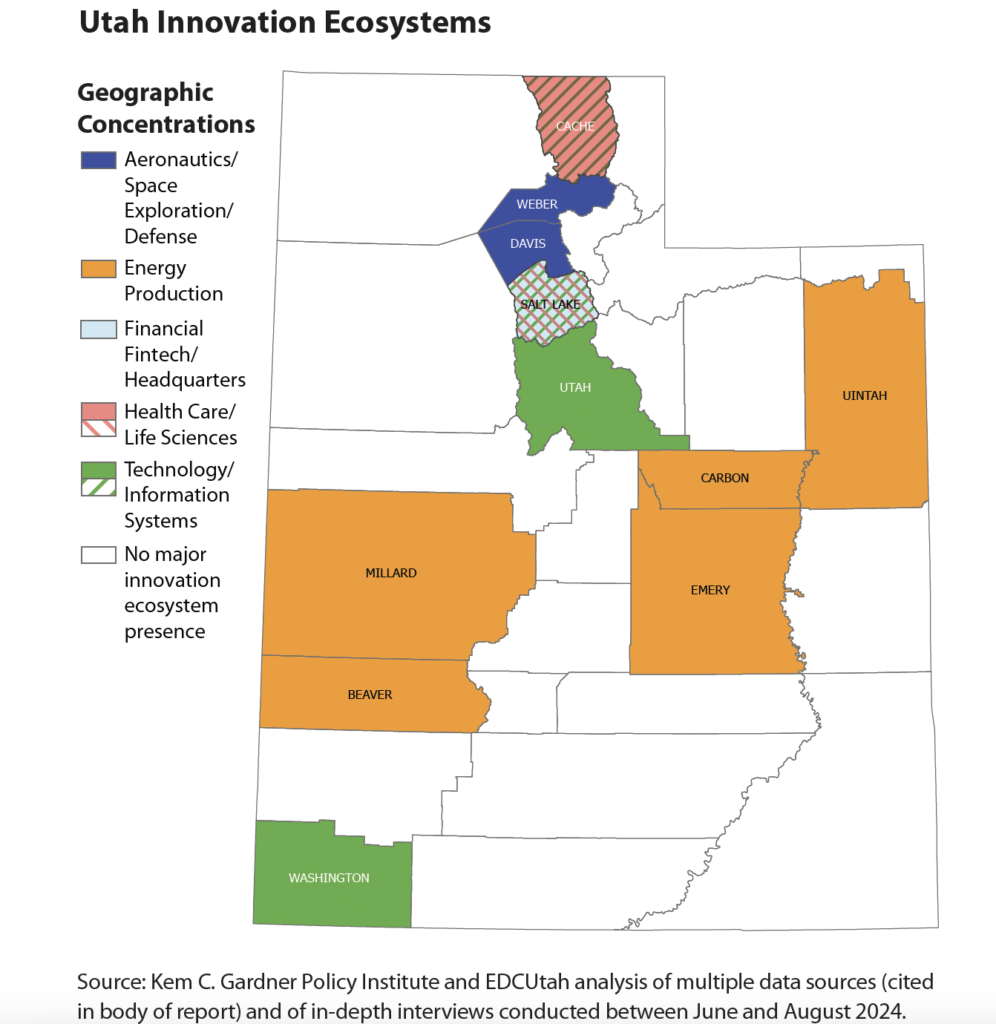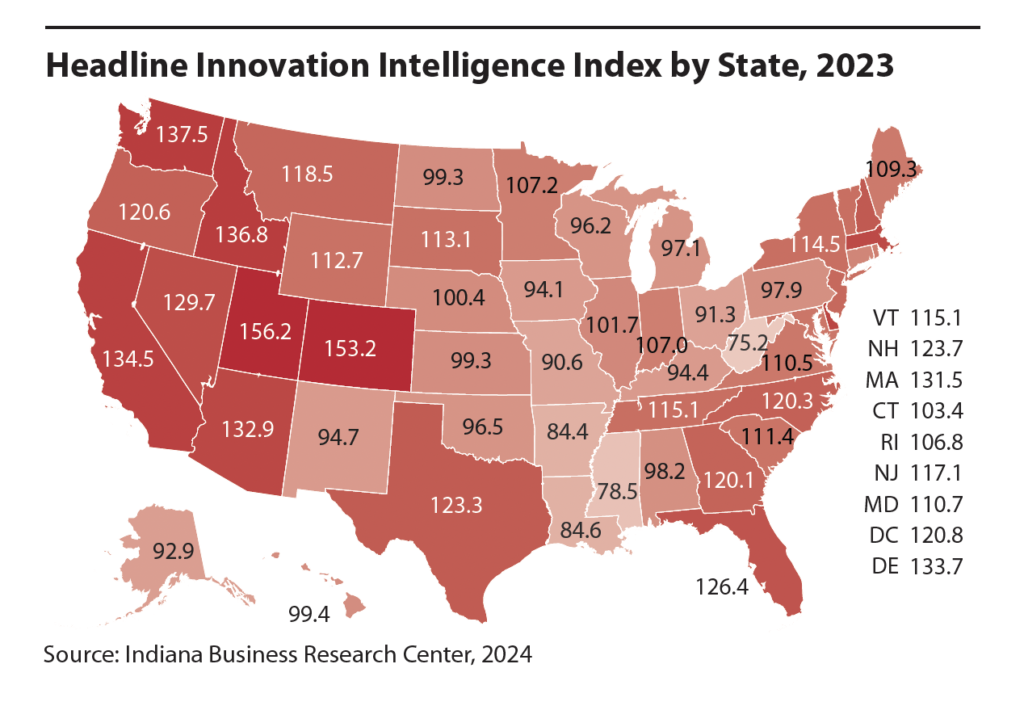By Xoel Cardenas, Sr. Communications Specialist, Office of the Vice President for Research
Utah’s rich history of innovation spans transformative advancements like the electric traffic light to the artificial heart, to groundbreaking computer animation technology. These innovations drive economic growth, create jobs and address society’s most pressing challenges.
A new report from the Kem C. Gardner Policy Institute and Economic Development Corporation of Utah says the Beehive State has strong “innovation ecosystems” thanks to its higher education institutions, well-trained workforce, collaborative atmosphere, and culture of innovation driven by the culture of this state.
What is an innovation ecosystem?

The report defines an innovation ecosystem as a “dynamic set of actors, activities, artifacts, institutions and relationships that influence and are essential for innovative performance.” These ecosystems include complementary and interconnected relationships that evolve over time, supporting startups, fostering collaboration and driving research across diverse industries.
In Utah, this concept takes shape in five key industry-aligned innovation ecosystems, each uniquely positioned to leverage the state’s strengths and foster economic growth:
- Aeronautics, Space Exploration, and Defense
- Energy Production
- Finance, Fintech, and Headquarters
- Health Care and Life Sciences
- Technology and Information Systems
Innovation districts and hubs play a key role in ecosystems. Districts cluster leading institutions and companies with startups, incubators and accelerators, and groundbreaking technology through collaboration and idea sharing to solve complex problems.
What drives Utah’s innovation success?
Utah’s innovation success stems from its higher education institutions, skilled workforce, robust social infrastructure and collaborative culture. Startups emerging from these ecosystems transform research into real-world solutions, strengthening Utah’s economy. Beyond economic growth, the University of Utah’s research has led to groundbreaking advancements in maternal health care, Alzheimer’s treatment and power grid resilience during extreme weather events—showcasing how innovation addresses pressing societal challenges and improves lives.
Utah No. 1 for innovation capacity and outcomes
Utah ranks first among U.S. states for innovation capacity and outcomes, according to the latest The Innovation Intelligence Index (II3), produced by the Indiana Business Research Center at the Indiana University Kelley School of Business. This ranking reflects Utah’s performance across five core innovation metrics: human capital and knowledge creation, business dynamics, business profile, employment and productivity, and economic well-being.
The University of Utah’s role
Utah’s higher education institutions, including the University of Utah, are mentioned in the Gardner report, saying they offer degrees and programs which largely align with the state’s five industry-aligned innovation ecosystems. At the same time, the U continues to pioneer research that tackles critical societal issues. Initiatives such as improving maternal health care outcomes, enhancing sustainability through air quality studies, and advancing mental health treatments demonstrate the university’s commitment to driving solutions that benefit both Utah communities and the global population.
“The University of Utah excels in life sciences, health care, general engineering, and business degrees for financial services and fintech,” the report states, adding that the U’s undergraduate entrepreneurship program ranks 7th overall in the U.S. and 4th among public universities.
U of U innovation hubs mentioned in the Gardner report include the Center for Medical Innovation, Energy Futures Hub, and the Stena Center for Financial Technology.
“At the University of Utah, we act as a bridge between innovative research and impact, connecting students, faculty, staff and collaborators to the opportunities that drive Utah’s success.” said Dr. Erin Rothwell, Vice President for Research at the U. “Through our research, academic programs and partnerships we are committed to creating connections that support and grow a strong innovation ecosystem for the future.”
In addition to its degrees and programs, the U drives impact through collaborations with industry and government that foster tech transfer – the process of turning university research into marketable products and services. These efforts fuel economic growth, creating jobs and advancing innovation. Over 330 startups have been launched based on technologies developed at the U. In FY2024 alone, the U licensed 23 technologies and launched four new startups.
“Universities, technical colleges and community colleges offer a range of degrees and programs that effectively serve each ecosystem, from directly producing innovation to supporting the workforce,” states the report. “Anchor companies in Utah are pivotal in collaborating with government and educational institutions to foster innovation.”
Collaboration and innovation in action
One of Utah’s strengths lies in its ability to foster collaboration among universities, private organizations and government entities. The recent partnership between the University of Utah and Sandia National Laboratories exemplifies this commitment. This strategic alliance brings together world-class researchers to address critical challenges in areas such as energy, national security and advanced materials, further solidifying Utah’s position as a leader in innovation.
Troy D’Ambrosio, Vice President for Innovation, executive director of the Lassonde Entrepreneur Institute and assistant dean at the David Eccles School of Business, highlighted another unique aspect of the Utah Innovation Ecosystem: the integration of students into campus innovation. “We harness the creativity and energy of our students to spur innovation and give them real-world experience,” he said. “This leads to more innovation, creating a virtuous circle.”
The Gardner report also highlights Research Park, which ranks 13th among innovation districts nationwide according to a 2024 George W. Bush Institute report. The ranking reflects its success in attracting skilled professionals, raising income levels and creating employment opportunities. Research Park hosts a dynamic mix of research-driven companies and organizations, including ARUP Laboratories, which plays a critical role in advancing innovation and strengthening the local economy.
Utah’s success is further fueled by private sector philanthropists and organizations that partner with higher education to help students develop business skills and launch companies. According to the Gardner report, “Donors often ensure these partnerships are successful and lasting. Business professionals come together to share best practices and help universities and colleges prepare students to be part of the workforce.”
“The University of Utah has a long and rich history of innovation and entrepreneurship,” said D’Ambrosio. “We have hit a critical mass and scale of innovation and tech startup companies that have made our economy the strongest in the country. This innovation growth cycle will run for 20 to 50 years and put the Salt Lake metro area on par with Seattle and Silicon Valley.”
The University of Utah’s leadership in innovation is further reflected in its ranking among the top 10 public universities for issued patents and revenue generation. Over 330 companies have launched based on technologies developed at the U, with 23 new technology licenses and four startups in FY2024 alone.
Utah’s ability to foster collaboration and drive innovation has positioned it as a national leader in research and entrepreneurship. To sustain and expand this success, the Gardner report emphasizes the need for strategic investments in physical infrastructure and capital funding. Building on these strengths, the University of Utah is advancing bold initiatives to shape a transformative future for innovation and impact.
A vision for the future
The University of Utah’s commitment to innovation is evident in its forward-thinking initiatives. Recently, the U broke ground on a new Center for Medical Innovation, which will serve as a hub for pioneering health care solutions and advancing medical technology. This state-of-the-art facility exemplifies the university’s dedication to creating spaces that foster interdisciplinary collaboration and real-world impact.
Additionally, the U has partnered with EPIC Ventures to launch University of Utah Ventures, an initiative designed to enhance regional innovation by connecting entrepreneurs, researchers and investors. By nurturing a robust ecosystem for startups and commercialization, this partnership will drive economic growth and amplify the university’s role as a catalyst for innovation. Along with the pioneering efforts of Jefferson Moss, who leads the Utah Innovation Fund, we are ready to continue to support and grow innovation across the state.
These efforts align with the U’s strategic goals to expand its impact through collaboration, education and groundbreaking research.
“The University of Utah’s innovation success is built on collaboration and a commitment to solving real-world challenges,” said Bruce Hunter, Chief Innovation Officer at the Technology Licensing Office at the U. “By expanding partnerships and supporting entrepreneurial efforts, we’re creating solutions that drive economic growth, transform industries, and improve lives in Utah and globally. The possibilities ahead are truly inspiring.”
These initiatives reaffirm the U’s commitment to driving innovation, addressing societal challenges, and enhancing quality of life locally and globally.
Discover the full story behind Utah’s innovation success by reading the full report here.
Be part of the impact
We’re here to help researchers turn ideas into impactful solutions. Whether you’re seeking funding, building partnerships, or looking to amplify your discoveries, the Office of the Vice President for Research is here to support you.
Explore funding and resources to support your research journey here.
Disclose your research and discoveries here to explore opportunities for commercialization, collaboration and broader societal impact.
